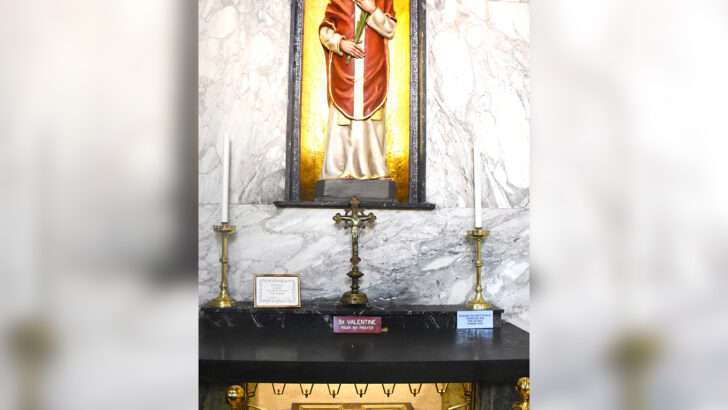The Church presents an ideal vision of marriage but it must also minister to people in their real struggles, Chai Brady hears.
As Ireland faces demographic challenges with fewer people getting married and fewer babies being born, there is an open question as to what the future may hold.
A recent study by the Iona Institute highlighted on last week’s front page revealed that religious couples have significantly higher fertility rates than their secular counterparts. The report shows that practicing Catholics in Ireland have an average of 2.1 children per family, compared to just 1.4 among non-religious couples.
This suggests that faith communities play a vital, yet often unseen, role in sustaining family life. Religious groups that uphold marriage and family values are expected to form the future core of the population. Amid this, Whitefriar Street Church in Dublin remains a focal point for couples seeking to strengthen their commitment to marriage, at least on February 14. Home to the relics of St Valentine, the church attracts visitors of all ages who recognise the value of sacramental marriage.
Christian marriage does not make sense without God’s grace”
Fr James Eivers O. Carm., Prior of Whitefriar Street Church, spoke to The Irish Catholic about St Valentine’s legacy. “Some people come here because they want to renew that commitment of marriage,” says Fr Eivers. “We get a lot of married couples praying in front of the relic. We also have a book of intentions, and if you read through it, you will see that marriage is not plain sailing—it’s sacrifice, it’s work.”
Fr Eivers continued: “People committed to their vocation realise that to make it work, they need God’s grace. Christian marriage does not make sense without God’s grace, so they write, through the intercession of St Valentine, ‘please help my marriage.’”
Martyr for marriage
St Valentine, a 3rd Century priest, lived during Emperor Claudius II’s rule. The emperor forbade soldiers from marrying, believing single men made better warriors. St Valentine defied this law by secretly marrying couples. For this, he was arrested, tortured, and executed on February 14, 269 AD.
“Why is St Valentine a martyr? Why is he the saint we look to for Christian marriage?” asks Fr Eivers. “Because of that sense of sacrifice. People pray before the shrine, seeking guidance in their marriage. The world markets the idea that marriage can come and go, the IKEA idea of marriage. But it is not plain sailing.”
Fr Eivers warned: “The worry I have with St Valentine is that he gets mixed up with Cupid, this strange, almost candy floss spirituality of arrows shooting through the sky – that is not Christian marriage.”
He continued: “Marriage is all about sacrifice. Aquinas says the vocation to marriage is about really willing the good of the other. It’s not just saying, ‘I want to spend my life with you’—it’s about getting to know you more each day and deepening the mystery of marriage. It is not the priest who marries—the marriage is the sacrament between the two.
“Each day, what we see here in Whitefriar Street is the realisation that a married couple’s life is sacramentalised – they are the sacrament to each other. We turn to the saints, these powerful intercessors, to help us in our vocation.”
St Valentine’s relics
Whitefriar Street Church has housed St Valentine’s relics since 1836. Pope Gregory XVI gifted them to Fr John Spratt, a Carmelite priest known for his charitable work in Dublin. After ministering in Rome, Fr Spratt received the relics as a sign of esteem, symbolising solidarity between the Irish Church and Rome.
Following Fr Spratt’s death in 1871, the relics were placed in storage. In the 1950s, devotion to St Valentine was revived, and a new shrine was built, featuring a reliquary containing the saint’s remains. The shrine, designed by sculptor Irene Broe, depicts St Valentine in red vestments, holding the palm of martyrdom.
“Many couples visit to receive blessings. We also welcome individuals, tour groups, school groups, scouting groups, and university students,” said Fr Eivers.
Guidance
Fr Eivers noted that people visit for different reasons. “Some come because they have lost a spouse, and that love is still there. There’s still that profound connection with someone you’ve spent your whole life with. There’s an element of coming and praying to St Valentine for consolation and healing.”
He said the depth of faith present at the shrine is evident, particularly when looking at the book of intentions. “One of the things with the book to St Valentine is that people also give thanks for prayers that have been heard—God does hear our prayers.”
Catholic Marriage in Ireland
The Iona Institute report also found that religious married couples report higher levels of marital satisfaction. Over 75% of practicing Catholic couples surveyed said their faith played a key role in sustaining their marriage, compared to just 40% of non-religious couples.
He stands as a witness to and a defender of love”
Fr Eivers said that while the Church presents an ideal vision of marriage, it must also minister to people in their real struggles. “The Mendicants, in terms of religious orders, are very much with the people. There’s a sense of wanting to minister where they are at—there is the ideal the Church puts forward and then there is the reality in which people live.”
In an era where marriage faces societal challenges, Fr Eivers reiterated the importance of faith, “People pray before the shrine, primarily seeking guidance in their marriage. Marriage is not about perfection; it’s about commitment and choosing to love even when things are difficult.”
He added that marriage requires resilience and a willingness to grow, saying: “Love is an act of will. It is something you choose every day. In Christian marriage, you say, ‘I choose to love you even when it’s difficult, even when things are not perfect.’ That is what makes it sacramental.”
He pointed said that nowadays people sometimes view love as merely an emotion. “Emotions come and go, but true love is deeper. It is about self-giving, about sacrifice, about living out your vocation in a way that reflects God’s love,” Fr Eivers said.
St Valentine, as a martyr, can continue to inspire the faithful, according to Fr Eivers.
“He paid the ultimate price for his efforts by being executed. He stands as a witness to and a defender of love and marriage as well as freedom of religion,” he said.
Fr Eivers stated that people today can draw strength from St Valentine’s story as he “reminds us that love is not always easy, that it sometimes requires courage. But it is worth it”.
Living tradition
As couples and individuals seek strength in their vocation, St Valentine can be an example to them. While St Valentine’s feast day has become highly commercialised, the shrine at Whitefriar Street Church stands as a reminder of the power of sacrifice and faith. Each year, the tradition continues, with visitors from across Ireland and beyond coming to seek the intercession of the saint who gave his life for love and marriage.
Love is an act of will. It is something you choose every day. In Christian marriage, you say, ‘I choose to love you even when it’s difficult, even when things are not perfect.’ That is what makes it sacramental”


 Chai Brady
Chai Brady The shrine venerating St Valentine at Whitefriar Street Church in Dublin’s inner city. Photo: Chai Brady
The shrine venerating St Valentine at Whitefriar Street Church in Dublin’s inner city. Photo: Chai Brady 